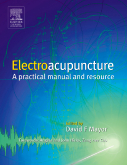Description
This book presents an overview of the theoretical foundations of
electroacupuncture, together with experimental and clinical evidence
for the efficacy of electroacupuncture in its various forms. It also
provides guidance on the effective clinical practice of
electroacupuncture, illustrated with informative case histories. It
serves as an excellent introduction on the subject, covering all the
key information a beginning practitioner would need to know, as well
as exploring avenues for advanced practice. The accompanying CD-ROM
is an ideal research tool, providing searchable chapters from the
book as well as an extensive database of more than 8,000 clinical
trials that can be accessed via the CD-ROM or through a companion
website.
Key Features
*Clear and accessible guide to an increasingly popular form of
acupuncture practice
*Designed for both technically and non-technically minded readers
*Provides a basis for immediate practical application in a variety of
clinical situations
*Case studies from expert practitioners in the field illustrate the
variety of possible approaches
*Only book on the subject to offer both practical suggestions and
thorough exploration of the research behind the practice
*Bridges the gap between traditional and modern scientific approaches
to acupuncture
*Sifts and sorts what is often confusing or highly technical material
into manageable and practical information
*Includes an interactive CD-ROM containing over 15,000 references
*Fully searchable database of more than 8,000 clinical studies is
accessible via the accompanying CD-ROM and website
*Database includes material from thousands of studies never before
available in English - translated from Chinese, Russian, Ukrainian
and other European languages
*Comprehensive glossary defines and explains important concepts
- Contents -
Part 1 Initial Orientation. Introduction. Electroacupuncture East and
West: the historical context.
Part 2 Electromagnetism and vibration: concepts and terminology.
Electroacupuncture in context: the effects of electrotherapy.
Neurophysiology, acupoints and meridians: Western and Eastern
perspectives. How electroacupuncture works I Observations from
experimental and animal studies. II Gathering the threads - from
observations to mechanisms and models. Does electroacupuncture work?
Evaluating the controlled clinical trials. Acupuncture in clinical
practice; an overview, . Psychological and nervous conditions. Stroke
and cerebrovascular disease. Peripheral motor disorders. The immune
system and the endocrine system. Disorders of the skin and hair., eye
and ear, nose, throat and mouth. Obstetrics, gynaecology and the
breast. The cardiovascular system. The respiratory system. The
gastrointestinal system, liver, gallbladder and pancreas. The
genitourinary tract. Pain and its treatment. Neurogenic pain - Head
and facial pain - Neck pain. Musculoskeletal conditions: an
integrated approach. Acupuncture anaesthesia. Postoperative pain.
Addiction. Appetite regulation and weight control.
Part III Technology and Practice. The technology of acupuncture.
Tools of the Trade. Practicalities. The basic do's and don'ts. An
integrated approach. Conclusion and the view ahead.
Appendix 1 Resources: information, organizations and suppliers.
Appendix 2 Technology in practice: assessment, legislation and
insurance.


